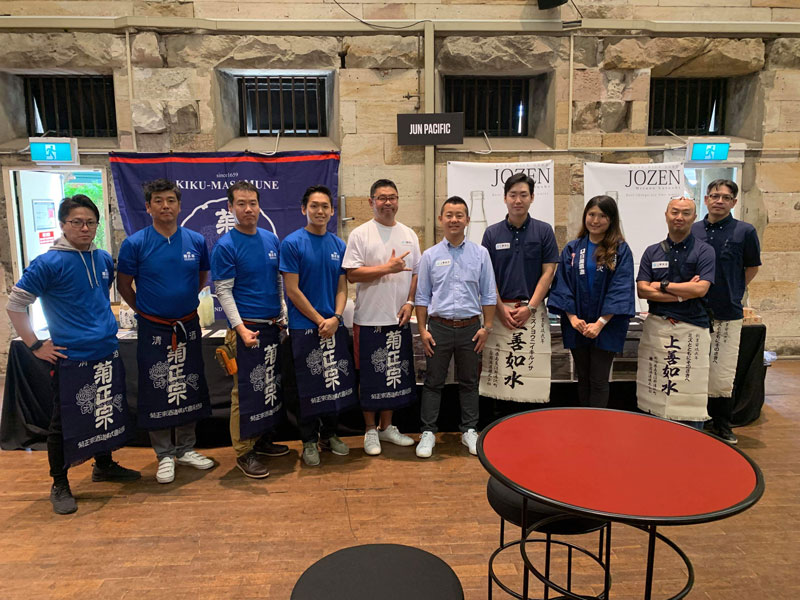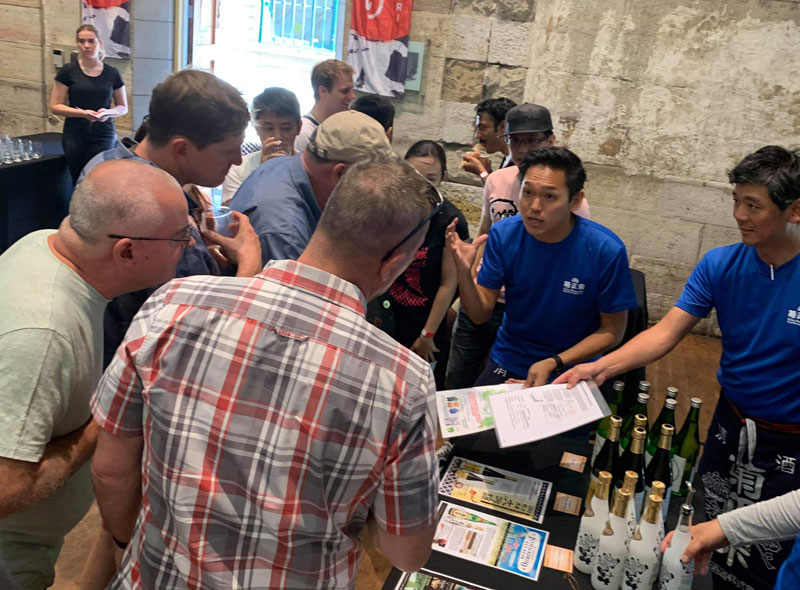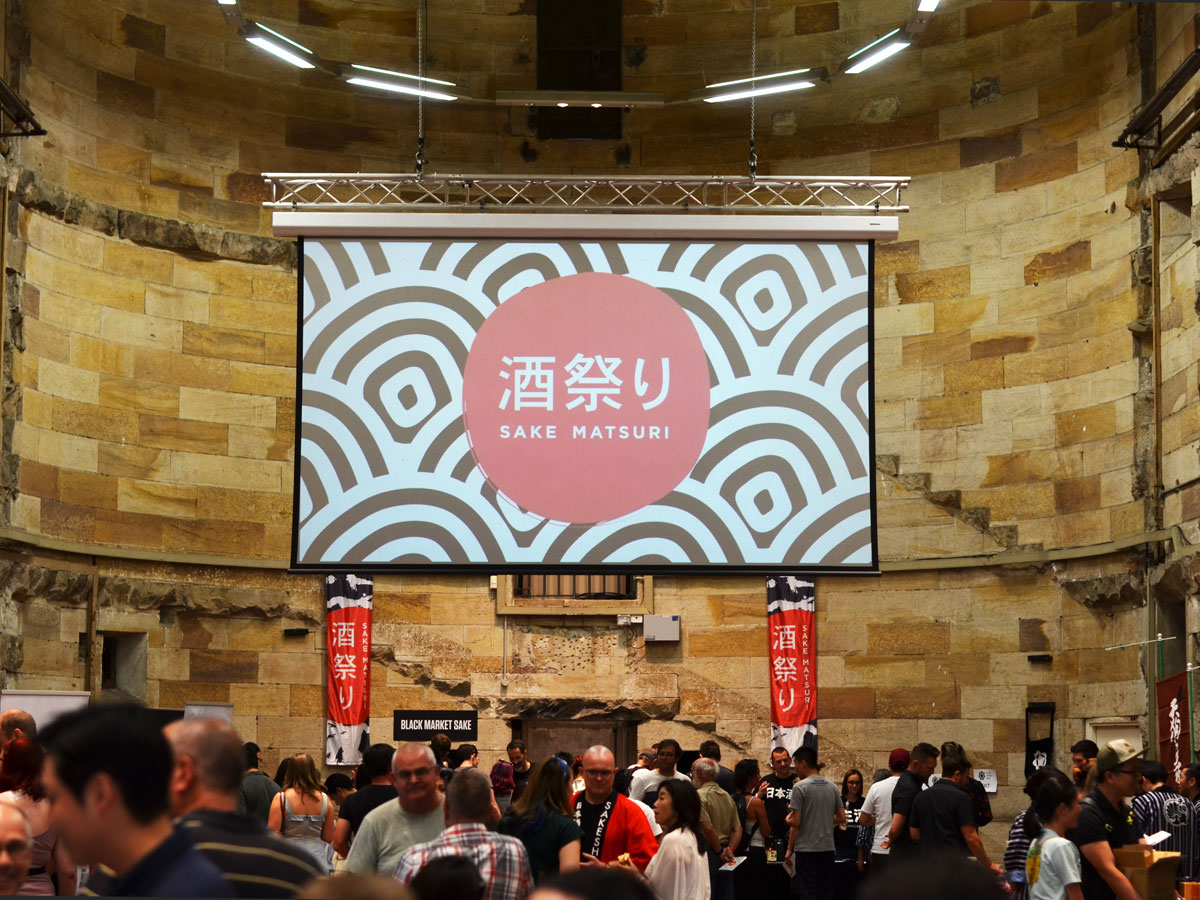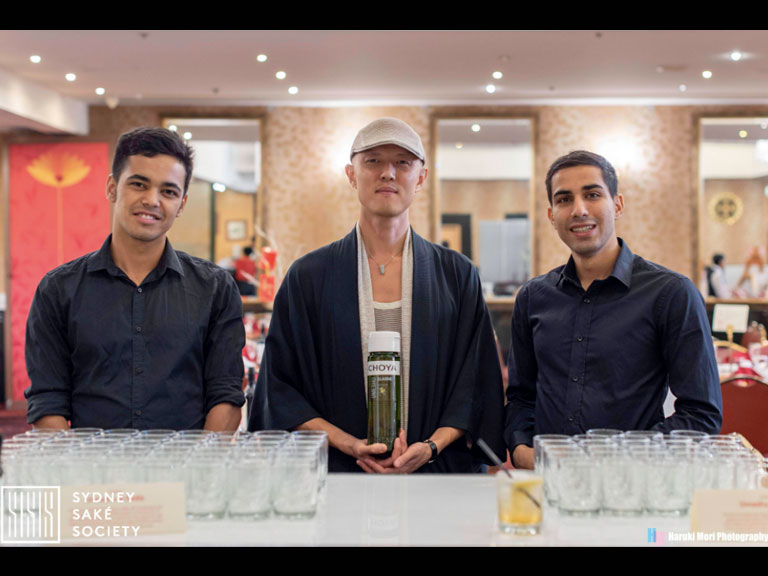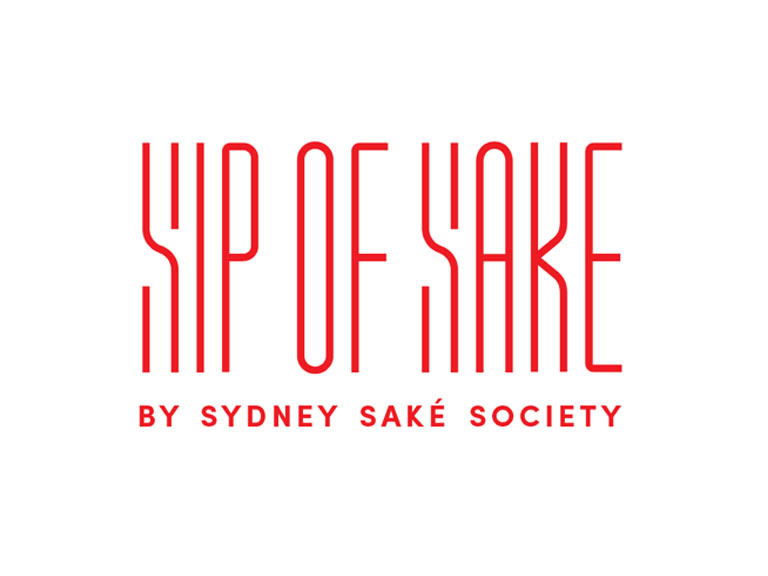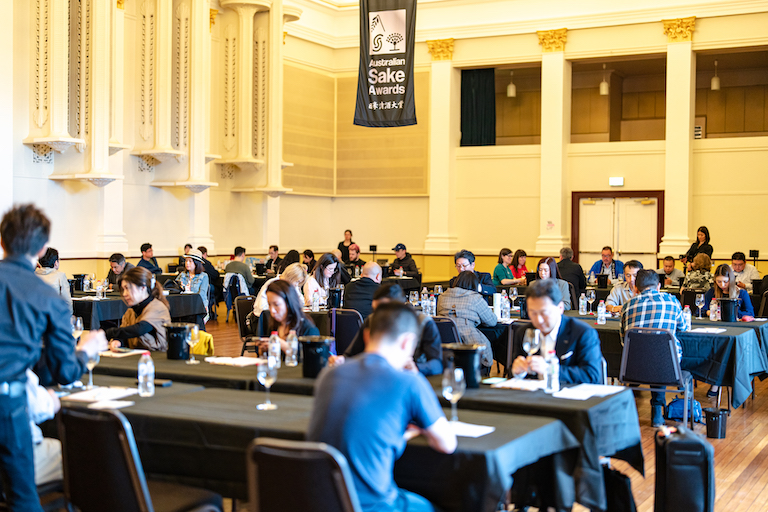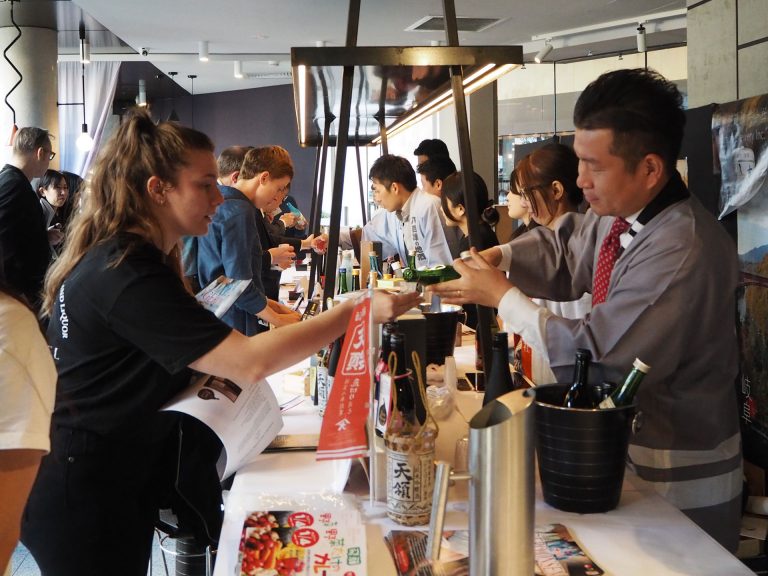Sydney’s biggest saké festival was back with this year’s event being one the best yet. Sydney’s Sake Matsuri 2019 featured more Toji and brewery workers than ever before with representatives flying in, as well as our favourite local Aussie distributors discussing the incredible taste, texture and unique qualities of Japanese saké.
Sake Matsuri (matsuri meaning festival) was created in collaboration with 5 great Aussie distributors known as Nihonshu Australia (Black Market Sake, Déjà vu Sake Co, Sakenet, Sakeshop by Chefs Armoury and SuperSake) and Revel (the team behind many of Melbourne and Sydney’s great events such as Pinot Palooza and Mould: A Cheese Festival) to help sake fans try many high quality, unique saké’s all in the one place and encourage new saké drinkers at the same time.
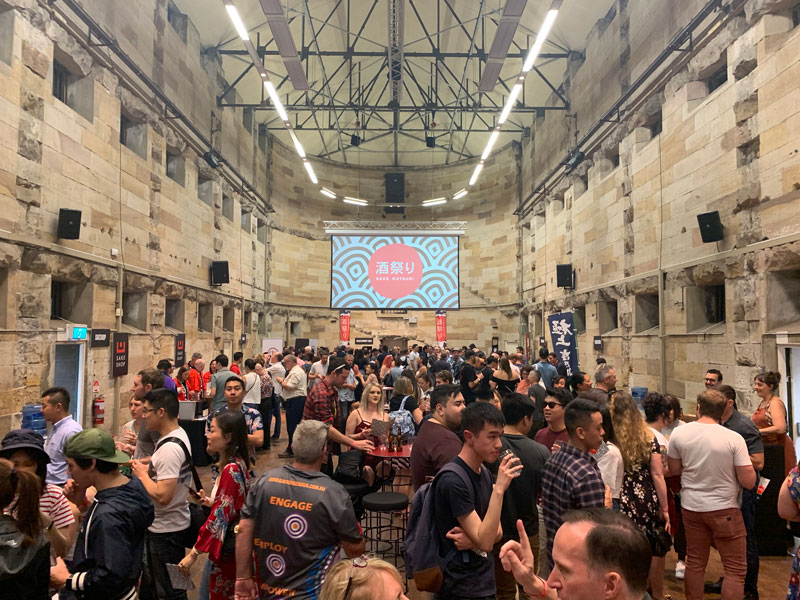
Since the very first Matsuri in 2017, new distributors such as Jun Pacific, Daiwa foods and Bishu wine imports have joined the exhibitor team with the festival getting bigger and better to showcase new and interesting saké’s to a rapidly growing fan base.
This year’s Sydney Sake Matsuri was held at the historic cell block theatre over 2 sessions, featuring saké from Black Market Sake, Daiwa Foods, Déjà Vu Sake Co, Jun Pacific, Sakenet and Sakeshop by Chefs Armoury, with food by the amazing team at Rising Sun workshop.

Before we could begin trying all the incredible saké, the team at Revel gave out the most important piece of drinking equipment, a drinking glass, in this case a beautiful stemless crystal glass to keep (included in ticket price). We quickly noticed that each table seemed to have at least 6 different saké’s and we were free to try any and all of them; with so many choices, we decided to begin with the rarest item on offer (so our palates were still fresh and it did not run out).
We began at Yoshinogawa brewery’s table who is represented by Déjà Vu Sake Co in Australia; we were met by Mr. Kunihiro Ono, a representative from Yoshinogawa brewery, who has flown from Japan to showcase his brewery’s historic saké (Yoshinogawa is the 8th oldest brewery in Japan); He kindly poured us a drink of one of the rarest saké we have had the privilege of trying, a special release 470th anniversary Daiginjo limited to 1,000 bottles worldwide; as well as answer a few questions.

Mr Ono, Can you please tell us a little about your brewery?
“Our Brewery is 471 years old, having started in 1548 and is the oldest brewery in Niigata prefecture. Our brewery is in Nagaoka area which is famous for its rice fields.”
Can you tell us why you chose to attend this event?
“We attended to support Déjà Vu Sake. Déjà Vu supports us in Australia and we really wanted to meet our fans here, too.”
What has been the most popular saké at your stand?
“The most popular has been the Yoshinogawa Shinkogura 7 year Daiginjo, maybe because it’s limited.” *laughs*
Is there anything you wish people knew about saké?
“Sake is matched with all food, I think it’s better than wine…sometimes. (laughs)”
Any final words you would like to share?
“Please visit our brewery to know more about Yoshinogawa Shuzo” (Yoshinogawa Brewery offers popular tours which are highly recommended)

Yoshinogawa Shinkogura 7 Year Old Daiginjo
(Due to its extremely limited production, we are unable to find anywhere outside of the festival that currently stocks this, we recommend contacting Déjà Vu Sake for more information)
This is an incredible saké made to celebrate a milestone few can claim, this ultra-limited saké was made from top grade Yamadanishki rice and aged for 7 years in -5 degree temperature to produce an incredibly smooth but very complex flavour. Only 1,000 bottles were made, of which only few remain.
Nose: mild creamy notes, delicate citrus fruits and rock melon.
Palate: Silky smooth- the fine texture is amazing, very balanced flavours of lychee and light citrus. There is definitely some depth too, likely from the ageing but nothing like traditional koshu (aged saké).
Our next stop was Tengumai saké by Shata Shuzo (also represented by Déjà Vu Sake); we were greeted by Mr. Hirohisa Ogawa and the future 8th generation Kuramoto (owner) Mr. Keiichiro Shata.

Can you tell us a little about your brewery?
“Our brewery is located in Ishakawa Prefecture, roughly between Tokyo and Osaka, facing the sea. It was established in 1823 and is still family owned even after 8 generations; the name means dancing goblin which was what the sounds of the forest reminded our original owner of” -Mr Shata (The popular tag for the brewery is it’s so good even a tengu/goblin would dance after drinking it)
Can you tell us what made you attend Sake Matsuri?
“It is our first time in Australia. We wanted to experience Australia and see what Australians think of and look for in our saké.” –Mr. Ogawa
How can we grow saké’s popularity in Australia?
“We should develop better food matching and tell our breweries story with saké.” –Mr. Ogawa
What has been the most popular saké at your stand?
“Tengumai Yamahai Junmai, it was very popular because of its range of flavour, both hot and cold.” –Mr Ogawa
“Yes, Tengumai Yamahai Junami, I think it was because it has a unique technique and range of flavours unlike any other saké.” –Mr. Shata
Any final words you would like to share?
“People can try more (saké) to experience all of the different flavours.” -Mr Shata

Tengumai Yamahai Junmai -served room temperature
(Available for purchase through various independent liquor stores, Dan Murphies and Qantas Wine Club)
Nose: rice husk and rice porridge
Palate: smooth and textural. Not to dry and not to sweet, the balance is superb. There is umami and a mild brown mushroom flavour.
-Served Warm
Nose: light umami and gently heated vanilla.
Palate: even smoother than room temperature with a mild creamy flavour and a long finish.
Our next stop was Australia’s only dedicated sake shop (aptly named Sakeshop), where we spoke with Mr. Leigh Hudson, owner and saké educator. The Sakeshop stand featured many different flavours and varieties including a particularly interesting Junmai made with 2 ancient 1,000 year old purple rice strains which were brought back from extinction (Asamurasaki and Okunomurasaki) as well the always popular (as well as one of our personal favourites) Kaze No Mori Alpha Type 3.

Can you tell us a little about Sakeshop?
“Sakeshop was established 7 years ago and is Australia’s only shop dedicated to Nihonshu, Japanese beer and Umeshu”
How do you believe we can grow saké in Australia?
“More events like this and for people to more and understand it; a lot of people have only had saké for the first time today”
“I believe the 3 main steps are ; 1. Education , 2. Tastings, 3. Events”
What has been most popular saké at your stand today?
“Kuze No Mori Alpha Type No.3, it has a balance of sweetness and acidity, as well as a fruity character.”
Any final words you would like to share with saké fans and people who are new to saké?
“Some people say just drink Junmai, but I like to say “don’t be a Junmai wanker”, try lots of saké to experience different flavours.”
We could not agree more with the above, there are many incredible Honjozo and even Futsushu that are well worth a try but are often dismissed because they are not Junmai, in our view the best way to know if you like something or not is to try it.

Kaze No Mori Alpha Type No.3
(Available exclusively through Sakeshop)
Nose: Filled with green apple, papaya and rockmelon.
Palate: Clean and smooth with all the fruity notes mentioned above. The saké is very complex but the clean balance makes it feel very approachable.
At this stage all the stands were very busy as several hundred people had arrived and were eagerly trying all of the wonderful items on offer. We spotted Shirataki Shuzo’s stand (represented by Jun Pacific) with a small gap in the crowd and took the opportunity to meet the current president of the brewery Mr. Shintaro Takahashi.

Can you tell us a little about brewery?
“Shirataki Shuzo is located in Niigata Prefecture; we have very heavy snowfall in winter so we have many excellent ski resorts. We use underground water which is very soft (low in minerals) as we make our saké to be light and smooth.”
Can you tell us why you chose to attend this event?
“We have been distributing our saké to Australia for 10 years and want to support our supplier in promoting it.”
How do you believe we can grow saké in Australia?
*laughs* “More drinking”
What has been the most popular saké at your stand today?
“Our most popular has been Jozen Mizunogotoshi Junmai Ginjo, it is light and smooth which is excellent for beginners”

Shirataki Jozen Junmai Ginjo
(Available in Sydney through Tokyo Mart and nationwide through various independent liquor stores)
Nose: very light and clean
Palate: Very clean and smooth, would work exceptionally well with food especially sashimi.
Our next stop was the Kiku-Masamune brewery’s stand. Kiku-Masamune is an excellent example of a popular brewery who is doing incredible things for sake education and tourism; they are based in Hyogo prefecture, a short trip from Osaka and run both a museum dedicated to saké as well as a fully functioning traditional taru (cedar barrel) factory (we highly recommend a visit to both).
Unfortunately the stand proved to be busy for us to get an interview; we did however try their excellent Taru saké.

Kiku-Masamune Taru Saké
(Available in Sydney through Tokyo Mart and nationwide through various independent liquor stores)
Nose: old damp wood/hay; the cedar is definitely evident
Palate: soft balance of cedar, light medium body and a delicious milky vanilla flavour. Really great.
The next stand we visited was by Sakenet Australia and featured a range of unique saké including the legendary Tamagawa Ice Breaker and a range of kan (warm) offerings. Sakenet has been instrumental in teaching Aussies about the joys of gently heated saké and countering the negative and false idea that only cheap saké is heated; as such they were the only stand were the majority of their premium saké were served kan (warm). We spoke with Rey Takahashi who is one the owners and former kurabito (brewery worker).
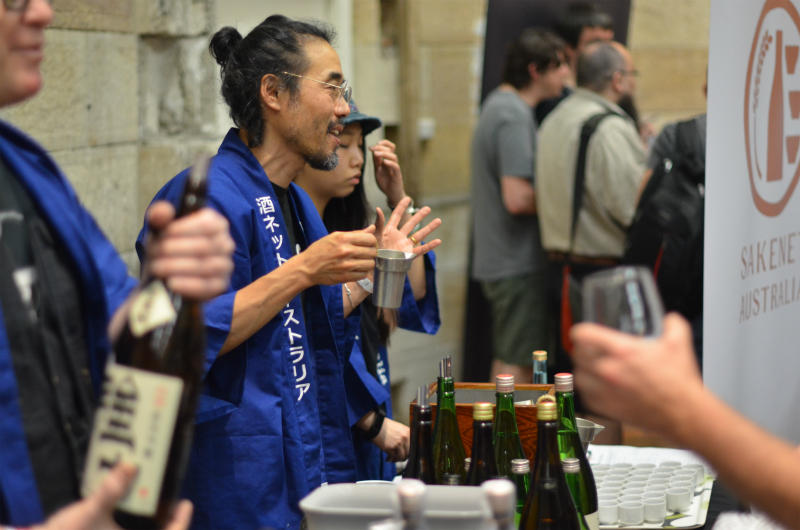
Can you tell us a little about Sakenet?
“Sakenet is a family business, it was started by my father so he could bring in the sake he liked for his restaurant (Yakitori Torisiya). We import and distribute sake, Shōchū, miso, shōyu, vinegar, and mirin. Our focus is kōji culture, which is the heart of Japanese food culture.”
Why did you choose to attend Sake Matsuri?
“We attend Sake Matsuri because it was our (Nihonshu Australia) idea to start this event and as a founding member we like to support it.”
What has been the most popular at your stand?
“Our most popular has probably been Hiokizakura Junmai-Ginjo Densho Goriki”
Is there anything you wish people understood about saké?
“I wish people would understand that sake isn’t wine. I realise that this is difficult as most of the industry professionals, from sake makers to restauranteurs, journo’s, educators, etc (in my opinion) treat sake like wine. Sake and sake culture has developed over hundreds of years with in Japanese food culture.”
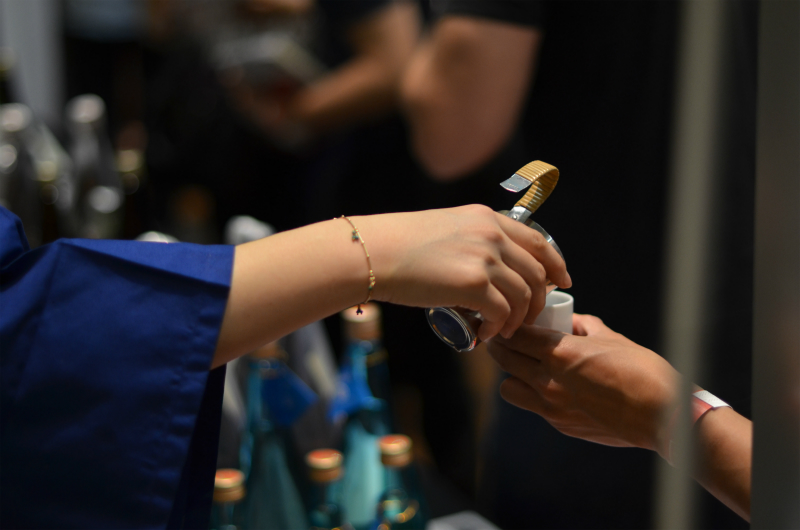
Hiokizakura Junmai-Ginjo Densho Goriki –served Kan (warm)
(Available through Sakenet and various independent liquor stores)
Nose: very mellow, creamy sweet spiced rice porridge
Palate: really smooth with soft, sweet spices and a pleasant warming finish
Next on our list to visit was Daiwa Foods stand. Daiwa Foods is a premium importer offering a huge range of Japanese saké, Shochu, Umeshu (they represent the popular Choya brand) and foods. For Sake Matsuri, Daiwa had brought 2 brands with 10 different varieties; offering anything from smooth and mellow to crisp, fruity sakés. Unfortunately Daiwa was another stand where we could not do an interview however we did learn the most popular saké was the Ranman Funaoroshi Junmai Namachozo (Pasteurised once) Genshu (undiluted).

Ranman Funaoroshi Junmai Namachozo Genshu
(available through sakejapan and various independent liquor stores)
Nose: creamy rice husk with some banana like fruity notes in the background
Palate: initially creamy but then a fine acidity comes through that acts as a palate cleanser and there is definitely some fruity flavours but hard to pick out any specific fruits while the finish is pleasantly crisp and acidic
Our final stand is Black Market Sake, an importer specialising in Junmai only, unique sake and in particular Nama (unpastuerised) saké. They are well known among saké fans particularly for more unusual saké’s with unique flavours. We spoke with Mr. Tim Watkins who was in charge of the Black Market Stand.

Can you tell us more about Black market sake?
“Black Market Sake was established in 2010 by Matt Young & Linda Wiss. At the time the availability of great Sake in Australia was very limited. Having extensively travelled throughout Japan for almost 20 years Matt understood that the successful future of Sake would rely on showing Australia the amazing potential of artisanal Sake and providing access to these wonderful products. Thus Black Market Sake was born.”
What made you attend Sake Matsuri?
“We have had the pleasure of participating in Sake Matsuri since its inception. This event has been vital in introducing sake to the wider market. There has been a growing interest in sake over the past 5-10 years, and festivals such Sake Matsuri have really helped continue this growth.”
How do you believe we can further grow sake in Australia?
“Here at Black Market Sake we have been involving ourselves in many public events involving sake, with the aim being to introduce/demystify this wonderful beverage to a wider audience. We regularly host public education sessions which has helped a lot of people become more aware and confident in expanding their interest and knowledge of sake.”
What has been the most popular at your stand?
“Hard to say but one of the most popular has been Chochin Shuzo Shinbushi 65”
Is there anything you wish people better understood about sake or any sake advice you would like to give our readers?
“My best advice is to try as much sake as you can! There are so many different styles of sake (from the cloudy Nigori, to sweet, savoury, aged ect.) Like anything our tastes are very subjective. We can be quick to dismiss a whole category of beverage simply by not liking one product. I’m confident there is a sake out there to suit most palates.”

Chochin Shuzo Shinbushi 65
(available through Black Market Sake and select independent liquor stores)
Nose: mellow herbal notes, clean with mild fruit notes
Palate: smooth, again there are some soft herbal notes as well as mild umami. A refreshing acidity introduces a fresh tropical fruit flavour. Excellent.
We must say a special thank you to all of the exhibitors and Revel for creating this incredible event, a place where saké fans new and old can come together and enjoy some of the best products available in Australia is something truly special. Thank you. Finally we hope to see all of our new saké friends at future events as we look forward to more saké.
Kanpai,
Daniel Zahrooni



